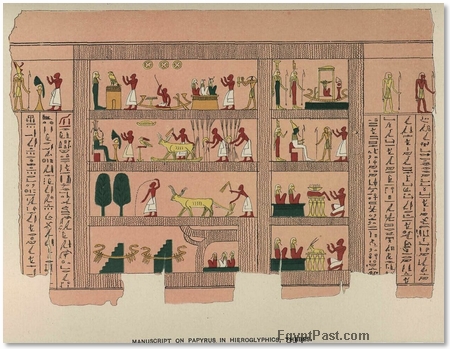Egyptian Houses

Manuscript in Hieroglyphics on Papyrus
Landed Property. -- —The tombs of the Old and Middle Kingdoms represent the various operations of large landed estates in all their complexity. Such private ownership of the soil, of large tracts, and even of whole villages, seems to have been a survival from the time when the princes of the nomoi were at the head of the independent districts which collectively constituted Egypt. A decided change is seen in the New Kingdom when the title to all land except that attached to the temples was vested in the king, and when it was worked for the state by slaves or let out at an annual rate per cent. The change came about during the Hyksos period or in the transition to the revived native dynasties. The biblical account of Joseph is of interest in connection with this.

Cartouche of Commodus
Houses.—The dwellings of the common Egyptians probably resembled those of the
fellahin of today, being mud hovels whose destruction accounts for the
formation of the tells which mark city sites. The dwellings of nobles and kings were more
pretentious, but no remains have survived. The only models by which to judge are some
ancient sarcophagi of house-like form, and some mural representations. Record has survived
of a palace which stood 300 cubits square.
pyramids Egypt Mummies Search Engines Link Report
Egyptian Cities | Egyptian Education | Ancient Egypt | egyptian clothing | Egyptian Houses | The Egyptians | Egyptian Family Life | Egypt and its Neighbours | Government in Ancient Egypt | Egyptian History | Military | Organization of Ancient Egypt | Recreation | Egyptian Religion | Pyramids | About | Privacy Policy | Site News | Site Map
EgyptPast.com - Facts and Information About the History of Ancient Egypt
-